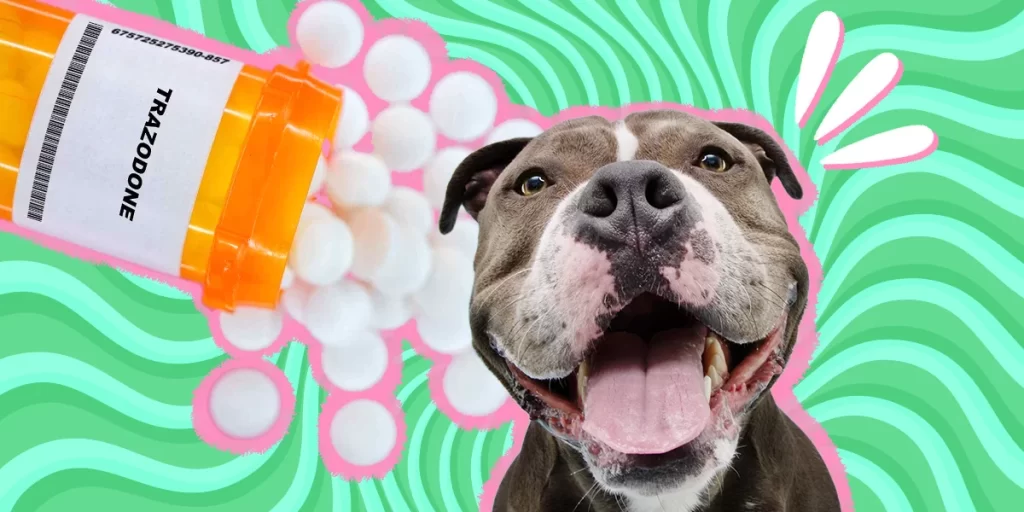Trazodone Dog Dosage: Safe and Effective Use of Trazodone for Dogs at 2024

Trazodone is a medication originally developed to treat depression in humans but has found a valuable role in veterinary medicine due to its calming effects. Veterinarians often use Trazodone to help dogs with anxiety and behavioral issues. It’s commonly prescribed for conditions like separation anxiety, noise phobias, and to keep dogs calm during stressful situations such as vet visits or thunderstorms.
One of the main benefits of Trazodone for dogs is its ability to reduce anxiety without heavily sedating them. This allows your dog to stay calm and relaxed while still being their usual, playful self. It’s especially useful for dogs that have trouble with changes in their routine or environment, helping them feel more secure and less stressed. Overall, Trazodone can greatly improve the quality of life for anxious or stressed dogs, making them happier and more comfortable in their daily lives.Now discuss Trazodone Dog Dosage, Trazodone for Dogs.

Factors Affecting Safe Trazodone Dosage
Several factors influence the safe and effective dosage of Trazodone prescribed for dogs, emphasizing the need for personalized veterinary guidance tailored to each dog’s specific circumstances.
Weight, Age, and Health Condition Considerations
- Weight: Dosage typically correlates with the dog’s weight, with larger dogs generally requiring higher doses to achieve therapeutic effects.
- Age: Younger and older dogs may metabolize medications differently, impacting how Trazodone affects their system.
- Health Condition: Dogs with underlying health issues, such as liver or kidney disease, may require adjustments in dosage to ensure safety and efficacy, as their ability to metabolize the medication may be compromised.
Behavioral Issues Being Treated
- Anxiety: Lower doses of Trazodone are often sufficient to manage anxiety-related behaviors like separation anxiety or noise phobias.
- Aggression: Higher doses may be necessary when addressing aggression, although careful monitoring is essential to avoid over-sedation or adverse effects.
Importance of Individualized Dosage Prescribed by a Veterinarian
- Tailored Treatment: Veterinarians assess each dog’s unique needs, response to treatment, and the severity of their behavioral issues to determine the most appropriate dosage.
- Monitoring and Adjustment: Regular veterinary consultations allow for ongoing evaluation and adjustment of Trazodone dosage based on the dog’s response and any observed side effects.
- Safety and Efficacy: Individualized dosing ensures that Trazodone is administered safely and effectively, optimizing its therapeutic benefits while minimizing potential risks.
By considering these factors and relying on veterinary expertise, dog owners can ensure that Trazodone is administered safely and efficiently to manage anxiety, aggression, and other behavioral issues, promoting their pet’s well-being and comfort.
Guidelines for Administering Trazodone Safely to Dogs
Administering Trazodones to dogs involves understanding its different forms, employing safe administration techniques, and ensuring your dog receives the full prescribed dose to effectively manage anxiety and behavioral issues.
Different Forms of Trazodone (Tablets, Capsules)
- Tablets: This tablets are solid forms of the medication that can be given directly by mouth or crushed and mixed with food.
- Capsules: Capsules contain powdered and can be administered whole or opened and sprinkled onto food.
Techniques for Safely Administering Trazodone
- Direct Administration: Place the tablet or capsule at the back of your dog’s tongue to encourage swallowing, followed by offering water or a small amount of food to aid ingestion.
- Mixing with Food: Hide crushed tablets or capsule contents in a small amount of food to mask the medication’s taste and encourage consumption.
Tips for Ensuring Your Dog Takes the Full Prescribed Dose
- Consistent Schedule: Administer Trazodone at the same time each day to maintain a consistent level of the medication in your dog’s system.
- Monitoring: Watch your dog closely to ensure they consume the entire dose and do not spit out the medication.
- Veterinary Guidance: Follow dosage instructions provided by your veterinarian precisely and consult them if you have any concerns about your dog’s compliance or response to treatment.
By following these guidelines, dog owners can safely and effectively administer Trazodone to their pets, ensuring the medication’s optimal efficacy in managing anxiety and behavioral issues. Regular communication with your veterinarian helps tailor the treatment plan to meet your dog’s specific needs, promoting their overall well-being and comfort.
Monitoring Your Dog’s Response
Monitoring your dog’s response to is crucial for ensuring its effectiveness in managing anxiety and behavioral issues. Recognizing signs of improvement, making necessary dosage adjustments, and scheduling regular veterinary check-ups are essential components of optimizing treatment outcomes.
Signs that Trazodone is Working Effectively
- Reduced Anxiety: Observing decreased signs of anxiety such as pacing, trembling, or excessive vocalization during stressful situations.
- Improved Behavior: Noticing more relaxed interactions with people and other animals, showing reduced aggression or fear responses.
- Stress Reduction: Your dog may exhibit less sensitivity to triggers like loud noises or changes in routine.
Adjusting Dosage Based on Response and Behavior
- Consulting Veterinarian: Regularly communicate with your veterinarian to discuss your dog’s response to Trazodone and any observed changes in behavior.
- Dosage Adjustments: Veterinarians may adjust the dosage based on your dog’s response to ensure optimal effectiveness without causing adverse effects.
- Monitoring Side Effects: Watch for signs of drowsiness, gastrointestinal upset, or unusual behavior that may indicate the need for dosage modification.
Importance of Regular Veterinary Check-ups to Monitor Progress
- Evaluation: Veterinary check-ups allow for comprehensive assessment of impact on your dog’s behavior and overall well-being.
- Health Monitoring: Regular visits help detect any emerging health issues or changes in behavior that may require adjustments in treatment.
- Tailored Treatment: Ongoing consultations ensure that Trazodone is administered safely and effectively, tailored to your dog’s individual needs and response.
By actively monitoring your dog’s response and maintaining regular veterinary check-ups, you can ensure the medication effectively manages their anxiety and behavioral issues. This approach supports your dog’s comfort and quality of life, promoting a happier, healthier pet.
Managing its Side Effects is generally well-tolerated by dogs when used to manage anxiety and behavioral issues. However, like any medication, it can occasionally cause side effects. Understanding common and serious side effects, along with strategies for minimizing them, is crucial for ensuring your dog’s well-being during treatment.
Common Side Effects and How to Manage Them
- Mild Sedation: Dogs may exhibit mild drowsiness or lethargy, especially when starting Trazodone. Provide a quiet, comfortable environment for rest.
- Gastrointestinal Upset: This can include vomiting or diarrhea. Administer Trazodone with food to reduce stomach irritation.
- Changes in Appetite: Monitor your dog’s eating habits and adjust their diet as needed to maintain nutrition.
Serious Side Effects and When to Seek Veterinary Care
- Allergic Reactions: Signs may include swelling, difficulty breathing, or hives. Seek immediate veterinary care if these symptoms occur.
- Serotonin Syndrome: Rare but serious, symptoms include rapid heartbeat, tremors, or seizures. Contact your vet urgently if these signs appear.
- Behavioral Changes: Unusual aggression or behavioral abnormalities should be reported promptly to your veterinarian for evaluation.
Strategies for Minimizing Side Effects While Using Trazodone
- Gradual Introduction: Start with a lower dose and gradually increase to minimize initial side effects.
- Administer with Food: Giving Trazodone with a small amount of food can help reduce stomach upset.
- Monitor Closely: Regularly observe your dog for any signs of discomfort or unusual behavior, and communicate promptly with your veterinarian about any concerns.
By being aware of potential side effects, monitoring your dog closely, and maintaining open communication with your veterinarian, you can effectively manage Trazodone treatment for your dog’s anxiety and behavioral issues while minimizing any adverse effects. This approach ensures a safer and more comfortable experience for your pet throughout their treatment regimen.
FAQs About Trazodone for Dogs
How quickly does Trazodone take effect?
Trazodone typically begins to take effect within 1 to 2 hours after administration. However, the full therapeutic benefits for managing anxiety and behavioral issues may take several days to weeks to become apparent as the medication accumulates in the dog’s system.
Can Trazodone be used with other medications?
Trazodone can often be used alongside other medications, but it’s crucial to consult your veterinarian before combining treatments. Some medications, particularly those affecting serotonin levels (such as SSRIs or MAOIs), may interact with Trazodone and increase the risk of serotonin syndrome. Your veterinarian will assess potential interactions and adjust dosages as necessary to ensure safe and effective combined therapy for your dog.
What should you do if you miss a dose or accidentally overdose?
- Missed Dose: If you forget to administer a dose of Trazodone, give it as soon as you remember, unless it is close to the time for the next scheduled dose. Do not double dose to make up for a missed dose.
- Accidental Overdose: If you suspect your dog has ingested too much Trazodone, contact your veterinarian immediately or seek emergency veterinary care. Watch for symptoms such as severe drowsiness, rapid heartbeat, or difficulty breathing.
Being informed about these FAQs ensures responsible use of Trazodone in managing your dog’s anxiety and behavioral issues. Regular communication with your veterinarian helps optimize treatment outcomes and ensures your pet’s safety and well-being throughout their medication regimen.




